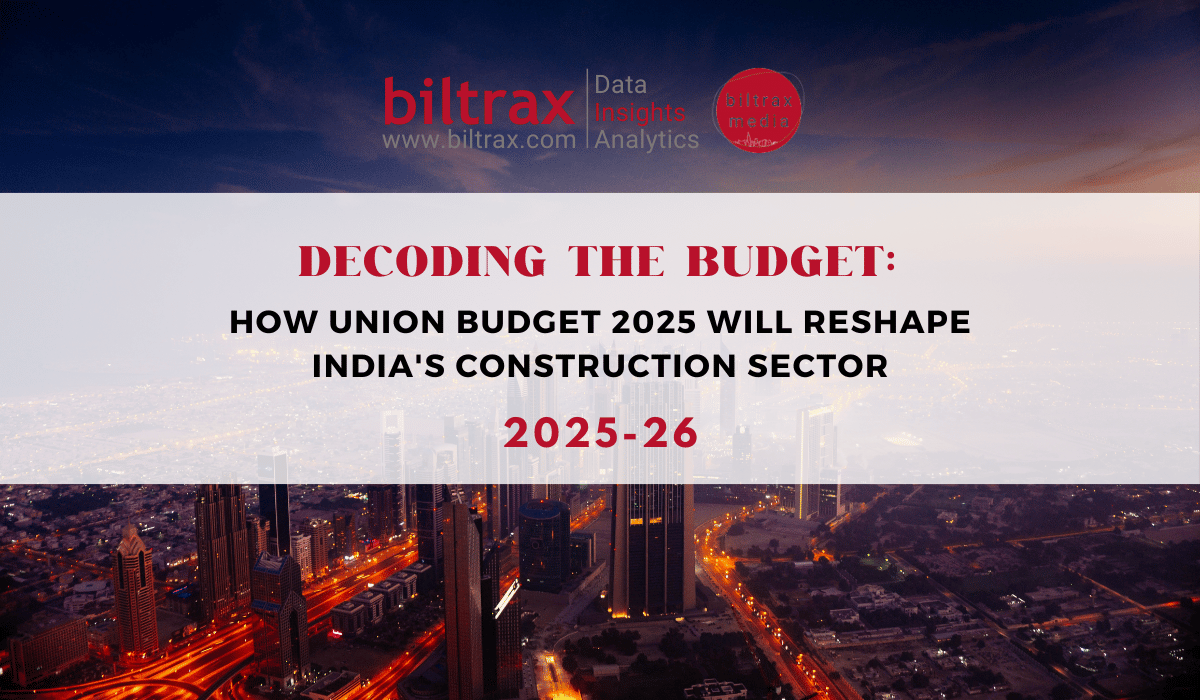Introduction
Indian real estate & building construction sectors are undergoing a prolonged slump since 2011-12. Considering the fact that we are going through a major structural change; major opportunities for renaissance exist to improve the functioning of this traditionally opaque, fragmented & disorganized industry.
During the last few years, we have also seen the government taking a special interest in this sector in the form of:
- Smart Cities Mission – Urban renewal and retrofitting program by Government of India with a mission to develop 100 cities (revised to 109) – budget 50,000+ Crore
- Housing for All by 2022 – An extremely ambitious plan to construct over 20 million urban homes
Besides these, we have the infrastructure works (railways, airports, ports, highways, etc – DMIC, Mumbai Port Development, GIFT, major private undertakings such as Lodha’s Palava in MMR) as well as an estimated 35,000 to 50,000 building construction projects coming up each year throughout India.
Not surprisingly, IBEF issued a report in January 2016 painting positive prospects of India’s real estate sector; growing from the US $93 billion (in 2014) to well over the US $853 billion by 2028.
The Indian construction industry has never had better times as far as the quantum of work is concerned & these are welcome projections for a developing country like ours which will provide bountiful career opportunities to thousands of professionals & lift millions out of poverty.
But there is a catch to this story ….
Conveniently hiding behind this rosy picture, is a major risk; which we are yet to meaningfully address; the bitter fact which can potentially derail the most thoughtfully planned projects. Senior construction executives fret about it to a certain extent because it interferes with their growth projections & can potentially drag down their stakeholder commitments. In spite of this it is still the proverbial ‘elephant in the room’ without a cohesive long term solution in sight.
The problem I am alluding to is the –
Shortage of skilled professionals Indian Construction Industry!
In this post, I am limiting myself to discussing numbers rather than skills/expertise
A cursory review of RICS’ report on ‘Real Estate & Construction Professionals in India by 2020’ dated November 2011 throws up a bunch of disconcerting statistics. Core professionals here are defined as Architects, Planners, Civil Engineers. The numbers have been presumably arrived at using global benchmarks on productivity for respective professionals.
Let us look at some of these numbers.

- Demand of core professionals in 2010 was 43.82 lakhs against a supply of 5.69 lakhs; a shortage of 87% (RICS report – November 2011)
For those who enjoy Cricket analogies this is equivalent to chasing 300 in an ODI & getting all out for 39 …! I don’t think I can recall such a loop-sided ODI ever.
- Now checking the future projections – Demand of core professionals expected in 2020 – 51.13 lakhs against a supply of 8.83 lakhs, still short by 83%! (RICS report – November 2011)
A majority of the above resources are Civil Engineers. So between 2010 – 2020, the cumulative projected requirement has been/estimated to be is ~ 46 lakhs against a supply of 5.33 lakhs! Shortage of 39+ lakh Civil Engineers over 10 years!

And here’s the bummer – Even though Indian engineering colleges are geared up to produce over 1.5 million engineers each year (2015-16); less than 40,000 out of those are Civil Engineers! So the next 10 years will only produce a fraction of Civil Engineers which were originally required during the previous 10 years!
What happened to those few thousands who graduated in the previous decade? Well apparently; many of them have chosen to get into new avenues which are more financially rewarding. My personal experience corroborates with this statement to a certain extent. Many of my classmates (VJTI Civil 2003) have made impressive careers in IT, finance, marketing, other businesses or have moved overseas for higher studies/work opportunities. I can imagine encountering a similar distribution from Civil Engineering graduates of other grade A colleges in the same batch range.
Considering we are a ‘developing nation’; we are in an unenviable situation as far as our development plans are concerned simply because we are so much short of indigenous nation builders!
Personally it is a bit ironic to experience multiple waves of digital innovations every few years (sometimes within months) with best-in-class products & services in form of Smartphones, Flipkart, Bigbasket, Ola/Uber, Paytm & so on; while our real-life (infrastructure, building construction) does not seem much different than what we had over 5 – 8 years back. It appears that the smartest people in our country have resigned to increasingly focus on sprucing up our virtual worlds while the challenging task of building the physical infrastructure is entrusted to remaining mortals. From an Indian perspective, this is not a new observation but the dichotomy of this trend is just much more conspicuous these days.
But let us not digress from the original discourse. Let us review trends about our friends in Architecture. Ubiquitous in each phase of real estate development & considering the significant influence they yield in India’s construction industry; one would imagine Architects would be high on numbers. Not really if you dig into data.
An Indian Architect is an extremely rare professional. Only about 1 out of 15000 Indians is an Architect. Compare it with per capita number of Indian Doctors (~ 1 in 1500) or Indian Chartered Accountants (~ 1 in 5000) & you can start imagining the rift. This is extremely counter intuitive to me because I am so used to working closely with Architects on a daily basis; still the 1:3:10 = Architect : CA: Doctor ratio is pretty hard to swallow.
Back to the statistics –
- In 2010, India’s demand for Architects was 3.66 lakh which was met by a cumulative of 45000 Architects. Falling short by 87%
- By 2020, India’s projected demand for Architect’s is close to 4.27 lakhs per year. The supply as per 2010 stats is a whopping (hold your breath …) 49000 only! What? Add up the consistent demand between 2010-2020 & you are staring at a cumulative shortage of over 4 million!

As of 2015-16, there are less than 80,000 registrations with Council of Architecture, country’s regulatory authority on education in Architecture (see registration statistics extracted from Council of Architecture)
From a parallel data source (listing of all Architecture colleges in India); as of 2015-16, the annual student intake of Architectural colleges in India is ~ 53000
While pouring over these numbers I also stumbled on an interesting statistic. The per capita ratio of Architects all over the world in a 2014 article.

A few observations before we summarize the discussion
Italy clearly has too many architects, China has too few. Japan leads the world in a number of registered Architects (~ 500,000 .. not on this list). I have added India (not on the original list) which happens to be worse than everyone on this list except China. The interesting thing to note is that this extremely low number of Architects (per Capita) has not stopped China from growing feverishly during the last decade! This anomaly only reiterates that the co-relation of development versus the number of Architects needs to be further investigated.

Summary
We could go into more granular details regarding the breakdown of these professionals, their relative roles & responsibilities & how they impact the overall real estate development process. However, the existing data sets point out to an obvious trend regarding the scarcity of building construction professionals in India. The lack of skilled/trained resources is partially leading to the delays in project deliveries, inferior quality output, cost overruns & general dissatisfaction of Clients & project Owners. During our discussion here, we have not yet delved into the quality of education being imparted in our institutions (in our discussion here) because considering the gap in numbers, it seems like a secondary issue (relatively speaking)
The sole purpose of the existence of thousands of consulting, contracting, development companies is to deliver projects to their end users/customers. Hence these statistics should raise alarm among these industry stakeholders (including local government bodies, central government, etc) who heavily depend upon these professionals. Mega government schemes such as Smart Cities, Housing for All by 2022; major private sector projects in healthcare, commercial/IT buildings, retail buildings are all counting on the humble duo of Architect + Civil Engineer for their execution. All this; in a sector which is expected to contribute anywhere between 8 to 15% to India’s GDP during the next decade.
Considering the ground realities; shouldn’t we be a little more concerned?
The first thing which comes to mind is whether the promised mega projects (Smart Cities, Housing for All, Infrastructure, etc) are going to be delivered with the existing resources in the proposed time-frame? Is there really a concrete plan in place to encounter this shortage of skilled personnel? For obvious reasons, I am finding it difficult to maintain my optimism here.
What can we really do about it?
Considering the enormity of this problem, there are not many short term solutions. Based on how going digital has upped the banking & financial markets during the last decade, I am batting for introducing a wave of technological interventions & offering them to existing & upcoming industry professionals; helping them adopting it at scale thereby adding to their knowledge base & productivity.
Here I am referring to standardized systems & processes expediting design delivery, accelerating tendering & procurement activities; centralizing project management & using smart documentation systems. All these improvements can significantly aid the decision making of our professionals & help them deliver X times more than what they are used to. At the same time, these measures are within the ambit of most organisations’ leaderships & do not cost much (as a small fraction of development costs) to implement. The onus thereby lies on our leadership who should invest in these programs with enthusiasm & patience level demonstrated by Venture Capitalists (investing in Indian startups) during the last few years.
Another approach is allowing generalists (e.g. Science, Commerce, Arts graduates with good academic records) to enter in the industry at a junior level; bringing them at par with technical professionals by intensive short term courses, & giving them opportunities to excel. This is not an entirely radical thought since one can already observe many ‘outsiders’ shining within our industry. It is just that this approach has not been formalized yet. Just sharing my observation – During my years with several grade A construction companies in the US; many of my colleagues were from varied non-construction backgrounds (Biology, Computer Science, Teaching & so on ) & they were extremely competent in their project delivery. These professionals had generally been encouraged to excel & were frequently trained to be on top of their expertise. I cannot imagine why this practice cannot be replicated in India.
As an industry, we are at a juncture where we cannot possibly blame Indian bureaucracy for delayed approvals or litigation related delays anymore. Those hurdles will continue to exist & the industry will have to perform despite the relative lack of sops. Focusing on what is within our control & building on the same is the way to go.
As usual; there is a great opportunity within this undesirable situation in this industry for those willing to give it all! There has never been a better time to be a (competent) construction professional in India!
Reference:
Navin Rajpal ( January 17, 2017) Indian Building Construction Industry’s ‘Elephant in the Room’ [LinkedIn post] Retrieved from https://www.linkedin.com/pulse/indian-building-construction-industrys-elephant-room-navin-rajpal/
Discover more from Biltrax Media, A Biltrax Group venture
Subscribe to get the latest posts sent to your email.




















